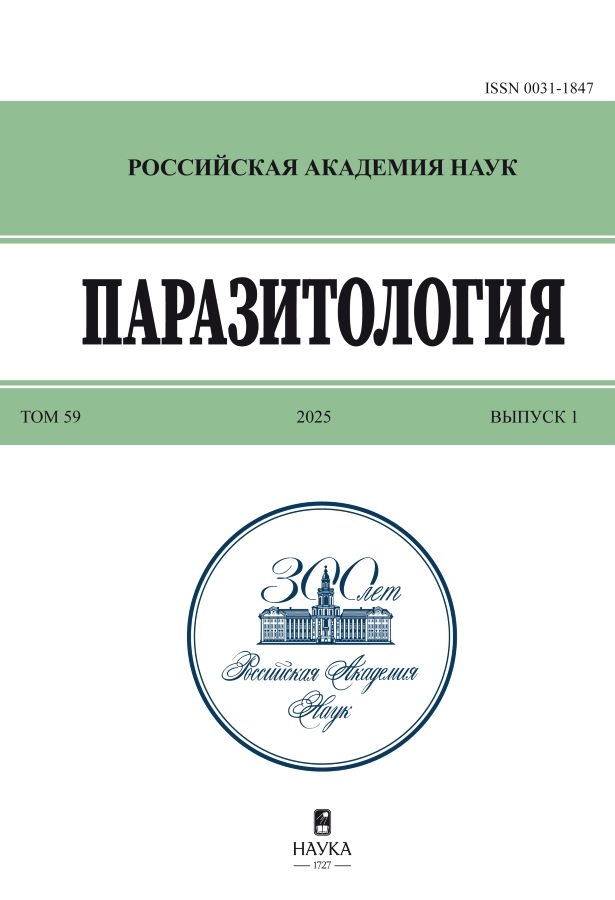Parazitologiâ
ISSN (print): 0031-1847
Media registration certificate: No. FS 77 - 66711 dated July 28, 2016
Founder: Russian Academy of Sciences
Editor-in-Chief: Pugachev Oleg Nikolaevich
Number of issues per year: 6
Indexation: RISC, CrossRef, White List (level 3), Web of science
The journal "Parazitologiya" was founded in 1967.
"Parazitologiya" is the first and leading peer-reviewed scientific journal on parasitology published in Russia.
The aim of the journal is to facilitate parasitology research in Russia and worldwide by providing an efficient, high-quality and modern platform for scientific communication.
The scope of the journal embraces a wide range of parasitological topics, except for highly specialized aspects of medicine and veterinary science.
- Biodiversity, distribution and systematics. Descriptions of new species are welcome if they also contribute to some general conclusions.
- Wide range of research objects: any parasitic metazoans, fungi and protists, as well as bacteria and viruses — if the study has general parasitological relevance.
- Studies on morphology that broaden understanding of form and function in parasitic organisms.
- Ecological parasitology, life cycles and transmission pathways of parasites; phylogeography.
- Host-parasite interactions at different levels.
- Evolution, co-evolution and phylogeny.
- General and fundamental questions of parasitology.
- Vector-borne diseases with natural reservoirs (if the accent is on parasitology rather than medicine or veterinary science).
The journal is published 6 times a year in Russian and English languages. The name of the English version is Entomological Review.
The journal is presented in many databases, including the Web of Science and RSCI.
Edição corrente
Volume 59, Nº 1 (2025)
Articles
Trans-Arctic distribution of marine fish digenean Progonus muelleri (Derogenidae) tested by molecular data
Resumo
In the digenean superfamily Hemiuroidea, a number of species are registered from a wide geographic range including the Arctic, Atlantic and Pacific Oceans. However, these distributions have not yet been confirmed with the molecular methods. In the present study, we performed molecular analysis of Progonus muelleri (Levinsen, 1881) (Derogenidae) from distant regions: the European sub-Arctic (the White, Barents and Pechora Seas) and the Pacific Northwest (the Sea of Okhotsk and the Pacific coast of the northern Kuril Islands). Two genetic lineages within P. muelleri, PM1 and PM2, are proved to occur in sympatry in the European sub-Arctic. We found minor differences in their maritae structure, and thus suppose they represent two pseudocryptic species. PM1 was also registered in the Pacific Northwest (PM1b) where it has differences in cox1 gene from the European sub-Arctic lineage (PM1a). The intramolluscan life-cycle stages of P. muelleri from the Sea of Okhotsk are described and compared with the ones from the White Sea. We hypothesize that PM1a, PM1b and PM2 are three distinct species, but this should be further tested.
 3-26
3-26


Haptoral hard part variability in Gyrodactylus teuchis Lautraite, Blanc, Thiery, Daniel & Vigneulle, 1999 (Monopisthocotyla: Gyrodactylidae) parasitizing cage-reared rainbow trout in Karelia
Resumo
Variability of the marginal hooks of Gyrodactylus teuchis parasitizing rainbow trout Oncorhynchus mykiss (Walbaum, 1792) was studied in cage farms situated in water bodies of the Baltic and White Sea drainage basins. Differences between groups proved to be predicated on two characters – marginal hook total length (MHTL) and marginal hook sickle length (MHSL). The probability of correctly identifying a specimen as belonging to the White Sea or Baltic group relying on the discriminant function based on these predictors is 98.6%. Meanwhile, when the function was tested on the worms whose samples were not involved in discriminant analysis, its predictions were correct only in 73% cases. These results indicate substantial intraspecific variability in the above mentioned characters in G. teuchis.
 27-33
27-33


Parasitofauna of Succinea putris (Mollusca: Pulmonata) in the territory of St. Petersburg and Leningrad Region
Resumo
During 2018–2024, the invasion of Succinea putris in St. Petersburg and the Leningrad Region was studied. The main attention was paid to the infection of snails with sporocysts of Leucochloridium. Three species of this genus were found: L. paradoxum, L. perturbatum and L. vogtianum. However, during the autopsy of Succinea putris, seven more species of parasites were noted, belonging to both trematodes and other groups of multicellular and even protists: ciliates of the Intramacronucleata subtype, coccidia Klossia sp., metacercariae of the trematodes Brachylaima mesostoma and Pseudoleucochloridium soricis, metacestodes Monocercus sp., nematodes of the Mermithidae family, dipteran larvae Pherbellia sp. In addition, various combinations of multiple infections formed by these parasites have been noted.
 34-48
34-48


Methods for collection and estimation of populations imago of mosquitoes (Diptera: Culicidae)
Resumo
The article provides an overview of quantitative methods for collecting mosquitoes that solve a number of important tasks: identifying the seasonal dynamics of the number of species, clarifying changes in the structure of the composition of dominant species under the influence of changing biotic and abiotic factors, and others. The problem of the correlation of the results of quantitative collections carried out at different times by different methods, different traps and in different landscape conditions is posed. We propose a unification variant of methods for quantitative collection a adults of mosquitoes in natural areas.
 49-71
49-71


Features of distribution and parasitism of Dermacentor silvarum Olenev, 1931 on the western periphery of the range
Resumo
In the Sothern Trans-Urals region (Kurgan region) 125 individuals of ticks were collected on the western periphery of the Dermacentor silvarum range during April–August 2020–2024 on the small mammals using the methods of the trapping grooves and trap lines. D. silvarum is found throughout the entire territory of Kurgan Oblast. During the long-term period (1980s and 2020–2024) its parasitization was noted on 19 species of small mammals and one hybrid form (russet and red-cheeked ground squirrel). D. silvarum was found more often than other small mammals on the common shrew, northern red-backed vole, narrow-headed vole, field vole and tundra vole. The occurrence and abundance of this tick are very low. D. silvarum belongs to moistened and afforested territories in the herb-bunchgrass steppe, but in forest-steppe and subtaira does not avoid open spaces.
 72-83
72-83











